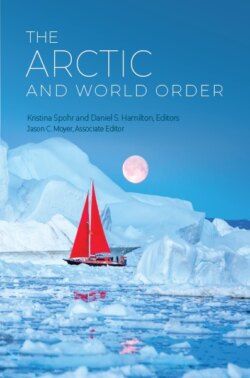Читать книгу The Arctic and World Order - Группа авторов - Страница 17
На сайте Литреса книга снята с продажи.
The Arctic Zone of Peace Narrative
ОглавлениеThere is broad agreement that a speech Mikhail Gorbachev delivered on October 1, 1987 in Murmansk in which he called for treating the Arctic as a “zone of peace” and proposed cooperative initiatives dealing with a range of concerns including arms control, commercial shipping, environmental protection, and scientific research provided the first high-level public expression of a policy narrative that had been percolating among analysts and practitioners interested in the Arctic starting in the mid-1980s.2 Propelled by a desire to celebrate the end of the Cold War and subsequently by the erosion of the bipolar order brought about by the collapse of the Soviet Union in the closing days of 1991, international cooperation in the Arctic seemed both appealing to the Arctic states themselves and lacking in global consequences that would engage the interests of the rest of international society.3 Under these circumstances, the vision of the Arctic as a distinctive “zone of peace” took root promptly and led in short order to the creation of the International Arctic Science Committee in 1990 and the adoption of the Rovaniemi Declaration establishing the Arctic Environmental Protection Strategy in 1991.
As it crystalized during the period 1987–1991, the Arctic zone of peace narrative acquired a set of interlocking tenets.4 First and foremost is the premise that the circumpolar Arctic is a distinctive region in international society with a policy agenda of its own. The defining features of this agenda are a common commitment to the pursuit of environmental protection and a broader desire to promote sustainable development in the circumpolar North. Second, the Arctic states themselves are the primary players in the Arctic arena; they can and should take the lead in addressing Arctic issues without regard to the preferences of outsiders. Third, the perspectives of the Indigenous peoples of the Arctic who have lived in the far North for centuries and who rightly regard the Arctic as their homeland deserve special consideration. Above all, the Arctic is not a vacuum with regard to the existence and operation of effective governance systems. Unlike Antarctica in the period prior to the conclusion of the 1959 Antarctic Treaty, the terrestrial portions of the Arctic lie securely within the jurisdiction of the Arctic states. The marine portions of the region are subject to the prevailing law of the sea, as articulated in the UN Convention on the Law of the Sea and a collection of associated arrangements. The Arctic states are willing to work cooperatively within this framework and are prepared to take the lead in establishing any supplemental arrangements needed to facilitate collaboration regarding issues of environmental protection and sustainable development in the region.5
The validity of these tenets was not beyond doubt.6 Even in the late 1980s, many of the Arctic’s environmental challenges (e.g. the impacts of radioactive contaminants, persistent organic pollutants, stratospheric ozone depletion) were non-Arctic in origin. The identity of the members of the set of Arctic states was subject to disagreement between those emphasizing the primacy of the five Arctic Ocean coastal states (the A5) and those advocating a broader perspective joining Finland, Iceland, and Sweden to the A5 producing the now familiar configuration of the A8. American policymakers were skeptical about the very idea of treating the Arctic as a distinctive region, especially as the United States emerged as the sole remaining superpower concerned with the need to maintain a global profile.7 Even the effort to delineate the southern boundaries of the region produced awkward results due to geographical asymmetries between the Eurasian Arctic and the western Arctic.
Nevertheless, the Arctic zone of peace narrative proved appealing to many and quickly gained traction in diplomatic circles.8 The result was the signing on June 14, 1991 of the Rovaniemi Declaration on the Protection of the Arctic Environment on the part of Canada, Denmark, Finland, Iceland, Norway, Russia (then still formally the Soviet Union), Sweden, and the United States.9 Although not a legally binding instrument, this ministerial declaration solidified the role of the A8, launched the Arctic Environmental Protection Strategy, and provided mandates for four Working Groups to get started on addressing a set of issues ranging from the impacts of pollutants to the conservation of Arctic flora and fauna and the protection of the Arctic marine environment. Because most others regarded the Arctic as a peripheral region of relatively limited importance to those located elsewhere, they let this process evolve without making any concerted effort to influence the course of events, at least during the early years.
Based largely on the efforts of the Working Groups and drawing on the enthusiastic engagement of government officials located in agencies beyond the foreign ministries of the member states, the machinery of Arctic cooperation made the transition from paper to practice fairly smoothly, building a community of dedicated participants along the way.10 Taking advantage of the resultant momentum and responding to the leadership of Canada in advocating the addition of sustainable development to the scope of the Arctic policy agenda, the A8 acted to broaden and deepen international cooperation in the Arctic by adopting the September 19, 1996 Ottawa Declaration on the Establishment of the Arctic Council.11 Though the council, too, is not rooted in a legally binding instrument, this step cemented the dominant role of the A8, expanded the scope of the vision embedded in the Arctic zone of peace narrative, and recognized formally the role of the Indigenous peoples of the Arctic as Permanent Participants in the pursuit of international cooperation in the region. As others have documented in some detail, this set the stage for a flow of significant initiatives during the succeeding years, all underpinned by the influence of a common interpretive framework.12
